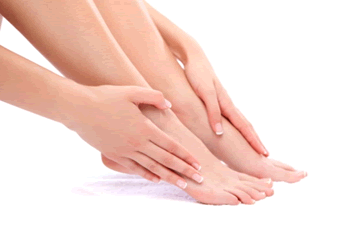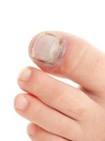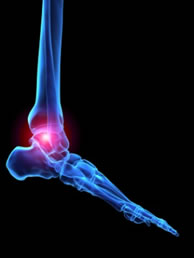
 (732) 246-1377
(732) 246-1377
 (732) 246-1377
(732) 246-1377 Those with diabetes must manage their feet carefully. Blood sugar levels that aren’t regulated can lead to a loss of feeling in the feet, which can further lead to injuries that may go unnoticed. Injuries that are left untreated can develop into infections, and in very severe cases, may need to be amputated. According to Dr. Rachel Natovich, who presented her research at the American Diabetes Association’s 75th Scientific Sessions along with her colleagues, “a person with diabetes has up to a 25% chance of developing a foot ulcer in their lifetime.” Research also suggested that diabetic patients with foot complications suffered decreased cognitive functioning. Diabetic foot care is important in maintaining a healthy lifestyle and preventing further injury.
Those with diabetes must manage their feet carefully. Blood sugar levels that aren’t regulated can lead to a loss of feeling in the feet, which can further lead to injuries that may go unnoticed. Injuries that are left untreated can develop into infections, and in very severe cases, may need to be amputated. According to Dr. Rachel Natovich, who presented her research at the American Diabetes Association’s 75th Scientific Sessions along with her colleagues, “a person with diabetes has up to a 25% chance of developing a foot ulcer in their lifetime.” Research also suggested that diabetic patients with foot complications suffered decreased cognitive functioning. Diabetic foot care is important in maintaining a healthy lifestyle and preventing further injury.
Diabetic foot care is important in preventing foot ailments such as ulcers. If you need your feet checked, see Dr. Dave Poonai of Livingston Footcare. Our doctor will treat your feet in addition to other podiatric-related needs.
Diabetic Foot Care
Diabetes affects millions of people every year. Diabetes can damage blood vessels in many parts of the body, including the feet. Because of this, taking care of your feet is essential if you have diabetes, and having a podiatrist help monitor your foot health is highly recommended.
The Importance of Caring for Your Feet
· Routinely inspect your feet for bruises or sores.
· Wear socks that fit your feet comfortably.
· Wear comfortable shoes that provide adequate support.
Patients with diabetes should have their doctor monitor their blood levels because blood sugar levels play such a huge role in diabetic care. Monitoring these levels on a regular basis is highly advised.
It is always best to inform your healthcare professional of any concerns you may have regarding your feet, especially for diabetic patients. Early treatment and routine foot examinations are keys to maintaining proper health, especially because severe complications can arise if proper treatment is not applied.
If you have any questions please feel free to contact our office located in North Brunswick, NJ. We offer the newest diagnostic tools and technology to treat your foot and ankle needs.
Millions of people are affected by diabetes each year. Diabetes damages blood vessels in all parts of the body, especially the feet. The legs and feet may develop slow blood flow, which causes neuropathy, or nerve damage. Once a diabetic patient develops neuropathy, it is important that the feet are well taken care of. Otherwise, the lower limbs may have to be amputated. This only happens in drastic cases, but it shows how seriously diabetic foot care should be taken.
It is very important to always wash and dry the feet thoroughly, especially in between the toes, if you’re a diabetic. Secondly, examining your feet and toes for redness or sores must be done, even if you do not feel pain. You may also want to examine your feet from the bottom. Try to avoid wearing colored socks to prevent infections that may occur from the dye. Well-fitting socks are also highly recommended.
A diabetic’s physician should always monitor their blood levels to test how well blood sugars are being maintained. In addition to giving advice about everyday eating habits and foot care, a physician may prescribe medicine to help with the diabetic patient’s neuropathy. It is also advised to see a podiatrist if experiencing any feet conditions. Toenails may also need to be taken care of by a podiatrist. This prevents patients from cutting too deeply around their cuticles, which can lead to infection.
A person can take care of their feet at home by following the instructions of their physician. Using creams on one’s feet is also an effective way to heal dryness. Proceed with caution when using tools to remove calluses, as severe diabetics may not be able to feel pain on their feet. If any complications arise do not hesitate to contact a podiatrist.
On a daily basis, diabetic feet must be checked. If you are ever concerned about something, contact your health care professional. You never want to wait until a wound becomes too severe to treat. If left untreated, gangrene may develop. Gangrene is a serious infection that can lead to sepsis or amputation. It is also important for diabetics to be on the lookout for ulcers. Ulcers are sores that develop from tissue loss on the skin. They can be quite painful and require intensive treatment. Early treatment and everyday inspection are imperative to staying healthy.
 John Lundstram of Oxford United kept on playing despite a broken toe and helped win the game against Cambridge United. Lundstram says, “He was not restricted by the injury,” which occurred, “about five minutes into the second half at Braintree,” when another player stood on his toe. Although there was pain, Lundstram went on to finish the game with his team with a victory.
John Lundstram of Oxford United kept on playing despite a broken toe and helped win the game against Cambridge United. Lundstram says, “He was not restricted by the injury,” which occurred, “about five minutes into the second half at Braintree,” when another player stood on his toe. Although there was pain, Lundstram went on to finish the game with his team with a victory.
A broken toe can be very painful and lead to complications if not properly fixed. If your heel is hurting, see Dr. Dave Poonai of Livingston Footcare. Our doctor will treat your heel pain symptoms in addition to other podiatric-related needs.
What to Know About a Broken Toe
Although most people try to avoid foot trauma such as banging, stubbing, or dropping heavy objects on their feet, the unfortunate fact is that it is a common occurrence. Given the fact that toes are positioned in front of the feet, they typically sustain the brunt of such trauma. When trauma occurs to a toe, the result can be a painful break (fracture).
Symptoms of a Broken Toe
· throbbing pain
· swelling
· bruising on the skin and toenail
· the inability to move the toe
· toe appears crooked or disfigured
· tingling or numbness in the toe
Generally, it is best to stay off of the injured toe with the affected foot elevated.
Severe toe fractures may be treated with a splint, cast, and in some cases, minor surgery. Due to its position and the pressure it endures with daily activity, future complications can occur if the big toe is not properly treated.
If you have any questions please feel free to contact our office located in North Brunswick, NJ. We offer the newest diagnostic tools and technology to treat your foot and ankle needs.
Trauma to the foot, especially the toes, can occur in many ways. Banging them, stubbing them, or dropping something on them are a few different ways this trauma can occur. Given the fact that toes are positioned in front of the feet, they typically sustain the brunt of such trauma. When trauma occurs to a toe, the result can be a painful break or fracture. Another type of trauma that can break a toe is repeated activity that places stress on the toe for prolonged periods of time.
Broken toes can be categorized as either minor or severe fractures. Symptoms of minor toe fractures include throbbing pain, swelling, bruising on the skin and toenail, and the inability to move the toe with ease. Severe toe fractures require medical attention and are indicated when the broken toe appears crooked or disfigured, when there is tingling or numbness in the toe, or when there is an open, bleeding wound present on the toe.
Generally, a minor toe break will heal without long-term complications. However, it is important to discontinue activities that put pressure on the toe. It is best to stay off of the injured toe and immediately get a splint or cast to prevent any more additional movement of the toe bones. You can also immobilize your toe by placing a small cotton ball between the injured toe and the toe beside it. Then, tape the two toes together with medical tape. Swelling can be alleviated by placing an ice pack on the broken toe directly as well as elevating your feet above your head.
Severe toe fractures may be treated with a splint, cast, and in some cases, minor surgery, especially when the big toe has been broken. Due to its position and the pressure the big toe endures with daily activity, future complications can occur if it is not properly treated. Pain associated with minor toe fractures can be managed with over-the-counter pain medications. Prescription pain killers may be necessary for severe toe fractures.
The healing time for a broken toe is approximately four to six weeks. In severe cases where the toe becomes infected or requires surgery, healing time can take up to eight weeks or more. While complications associated with a broken toe are immediately apparent, it is important to note that there are rare cases when additional complications, such as osteoarthritis, can develop over time. You should immediately speak with your podiatrist if you think you have broken your toe due to trauma. They will be able to diagnose the injury and recommend the appropriate treatment options.
 Baylor freshmen quarterback Jarrett Stidham will be unable to play for the rest of the season due to an ankle injury. Stidham originally began as a starter, where he filled in for Seth Russell, who was also injured. Stidham played a total of 10 games for Baylor for this season, but was hurt during halftime in the game against Oklahoma State. Stidham was replaced by third-stringer Chris Johnson, who helped lead the team to a win.
Baylor freshmen quarterback Jarrett Stidham will be unable to play for the rest of the season due to an ankle injury. Stidham originally began as a starter, where he filled in for Seth Russell, who was also injured. Stidham played a total of 10 games for Baylor for this season, but was hurt during halftime in the game against Oklahoma State. Stidham was replaced by third-stringer Chris Johnson, who helped lead the team to a win.
Barefoot running has its own share of benefits and disadvantages. If you need your feet checked, see Dr. Dave Poonai of Livingston Footcare. Our doctor will treat your growing feet in addition to other podiatric-related needs.
Broken Ankles
A broken ankle is experienced when a person fractures their tibia or fibula in the lower leg and ankle area. Both of these bones are attached at the bottom of the leg and combine to form what we know to be our ankle.
When a physician is referring to a break of the ankle, he or she is usually referring to a break in the area where the tibia and fibula are joined to create our ankle joint. Ankles are more prone to fractures because the ankle is an area that suffers a lot of pressure and stress. There are some obvious signs when a person experiences a fractured ankle, and the following symptoms may be present.
Symptoms of a Fractured Ankle
● Excessive pain when the area is touched or when any pressure is placed on the ankle
● Swelling around the area
● Bruising of the area
● Area appears to be deformed
If you suspect an ankle fracture, it is recommended to seek treatment as soon as possible. The sooner you have your podiatrist diagnose the fracture, the quicker you’ll be on the way towards recovery.
If you have any questions please feel free to contact our office located in North Brunswick, NJ. We offer the newest diagnostic tools and technology to treat your foot and ankle needs.
 According to a recent global study on Rheumatoid Arthritis (RA), North America has the biggest market for rheumatoid arthritis therapeutics. Europe follows at second. An increasing number of patients with rheumatoid arthritis are emerging in North America, causing a rise in research and development, in awareness among people of the condition, and in improved healthcare in the region. Drugs that treat RA include pain relieving drugs, corticosteroids, disease modifying anti-rheumatic drugs (DMARDs), biologics, and non-biologic drugs.
According to a recent global study on Rheumatoid Arthritis (RA), North America has the biggest market for rheumatoid arthritis therapeutics. Europe follows at second. An increasing number of patients with rheumatoid arthritis are emerging in North America, causing a rise in research and development, in awareness among people of the condition, and in improved healthcare in the region. Drugs that treat RA include pain relieving drugs, corticosteroids, disease modifying anti-rheumatic drugs (DMARDs), biologics, and non-biologic drugs.
Because RA affects more than just your joints, including the joints in your feet and ankles, it is important to seek early diagnosis from your podiatrist if you feel like the pain in your feet might be caused by RA. For more information about Rheumatoid Arthritis and its symptoms, consult with Dr. Dave Poonai of Livingston Footcare. Our doctor will assess your condition and provide you with quality foot and ankle treatment.
What Is Rheumatoid Arthritis?
Rheumatoid Arthritis (RA) is an autoimmune disorder in which the body’s own immune system attacks the membranes surrounding the joints. Inflammation of the lining and eventually the destruction of the joint’s cartilage and bone occur, causing severe pain and immobility.
Rheumatoid Arthritis of the Feet
Although RA usually attacks multiple bones and joints throughout the entire body, almost 90 percent of cases result in pain in the foot or ankle area.
Symptoms
- Swelling & pain in the feet
- Stiffness in the feet
- Pain on the ball or sole of feet
- Joint shift and deformation
Diagnosis
Quick diagnosis of RA in the feet is important so that the podiatrist can treat the area effectively. Your doctor will ask you about your medical history, occupation, and lifestyle to determine the origin of the condition. Rheumatoid Factor tests help to determine if someone is affected by the disease.
If you have any questions please feel free to contact our office located in North Brunswick, NJ. We offer the newest diagnostic tools and technology to treat your foot and ankle needs.
Although rheumatoid arthritis actually attacks multiple bones and joints throughout the entire body, ninety percent of people who actually develop this condition usually do so in the foot or ankle area. Those who develop this kind of arthritis in the feet usually develop symptoms around the toes and forefeet first, before anywhere else. Rheumatoid arthritis appears to have a genetic component. If it runs in the family, then you will be more likely to develop it as well.
Rheumatoid arthritis is an autoimmune disorder in which the body’s own immune system attacks the lining of the membranes surrounding the joints. This causes inflammation of the membrane lining, and the gradual destruction of the joint’s cartilage and even bone.
Some of the most common symptoms that are associated with RA include pain and swelling of the feet. Stiffness in the feet is also another common symptom that people experience. Those who have RA in the feet usually feel the pain in the ball or sole of their feet. This can get to be very painful at times. A person's joints can even shift and become deformed after a period of time.
In order to properly diagnose RA in the feet it is usually necessary for a doctor or podiatrist to evaluate the area. Your doctor will also question you about your medical history, occupation, etc., to determine whether anything in your lifestyle may have triggered the condition. There are a number of tests that may be performed to help diagnose RA such as a rheumatoid factor test, although there is no one single test that will tell you for sure if you have RA. There are different X-rays that can be taken as well to determine if a person has RA in their feet.
There is a range of treatment options for rheumatoid arthritis. Treatment of RA is usually a lifelong process that includes a variety of methods of treatment and therapy. Your doctor can prescribe special shoes that should help with arch support as well as heel support. A physical therapist can help those with this condition learn exercises which will keep their joints flexible. Surgery may be needed to correct some of the issues with the feet, such as bunions, and hammertoes. Fusion is usually the most successful surgical option for rheumatoid arthritis. However, people need to keep in mind that there are some risks associated with these surgeries.
 Samaritan’s Feet, a national faith-based nonprofit that fits children with new shoes at no costs, has donated about 700 shoes to families in Immokalee, Florida. About 36 volunteers helped children clean and fit their feet with new shoes. As kids get older, they quickly outgrow their shoes and periodically need new ones.
Samaritan’s Feet, a national faith-based nonprofit that fits children with new shoes at no costs, has donated about 700 shoes to families in Immokalee, Florida. About 36 volunteers helped children clean and fit their feet with new shoes. As kids get older, they quickly outgrow their shoes and periodically need new ones.
Looking out for potential foot and ankle injuries as well as general health is vital in maintaining proper development in children’s feet. If you need your feet checked, see Dr. Dave Poonai of Livingston Footcare. Our doctor will treat your growing feet in addition to other podiatric-related needs.
Keeping Children's Feet Healthy
Having healthy feet in childhood can help prevent medical problems later in life, namely in the back and legs. As children grow, their feet require different types of care from birth to school-age.
Although babies do not walk yet, it is still very important to take care of their feet.
· Avoid putting tight shoes or socks on his or her feet
· Allow the baby to stretch and kick his or her feet to feel comfortable
As a toddler, kids are now on the move and begin to develop differently. At this age toddlers are getting a feel for walking, so don’t be alarmed if your toddler is unsteady or ‘walks funny’. Be sure the child wears comfortable and protective shoes so that they can grow into their feet properly.
As your child gets older, it is important to teach them how to take care of their feet
Show them proper hygiene to prevent infections such as fungus
Be watchful of any pain or injury
Have all injuries checked by a doctor as soon as possible
Comfortable, protective shoes should always be worn, especially at play
Children of all ages are constantly developing and growing, and as a parent you want to make sure that nothing is hindering their maturation.
If you have any questions please feel free to contact our office located in North Brunswick, NJ. We offer the newest diagnostic tools and technology to treat your foot and ankle needs.
Having healthy feet in childhood can help prevent medical problems later in life, namely in the back and legs. As children grow, their feet require different types of care from birth to school-age.
Although babies do not walk yet, it is still very important to take care of their feet.
· Avoid putting tight shoes or socks on his or her feet
· Allow the baby to stretch and kick his or her feet to feel comfortable
As a toddler, kids are now on the move and begin to develop differently. At this age toddlers are getting a feel for walking, so don’t be alarmed if your toddler is unsteady or ‘walks funny’. Be sure the child wears comfortable and protective shoes so that they can grow into their feet properly.
As your child gets older, it is important to teach them how to take care of their feet
Show them proper hygiene to prevent infections such as fungus
Be watchful of any pain or injury
Have all injuries checked by a doctor as soon as possible
Comfortable, protective shoes should always be worn, especially at play
Children of all ages are constantly developing and growing, and as a parent you want to make sure that nothing is hindering their maturation. This includes caring for their feet, as healthy feet are important in order to live a normal, fulfilling life.
 Heel pain can be caused by several different reasons, but one particular condition to look out for is plantar fasciitis. Plantar fasciitis results when the tissue between your heel bone and toes, called the plantar fascia, becomes inflamed. This can be caused by factors such as weight, your age, and the kind of physical activity you do. Women are more prone to plantar fasciitis than men, and it is important that the condition is treated when diagnosed. Some treatment options include physical therapy, exercising programs, deep tissue massage, wearing orthopedics, and surgery.
Heel pain can be caused by several different reasons, but one particular condition to look out for is plantar fasciitis. Plantar fasciitis results when the tissue between your heel bone and toes, called the plantar fascia, becomes inflamed. This can be caused by factors such as weight, your age, and the kind of physical activity you do. Women are more prone to plantar fasciitis than men, and it is important that the condition is treated when diagnosed. Some treatment options include physical therapy, exercising programs, deep tissue massage, wearing orthopedics, and surgery.
Plantar fasciitis can be very painful and inconvenient. If your heel is hurting, see Dr. Dave Poonai of Livingston Footcare. Our doctor will treat your heel pain symptoms in addition to other podiatric-related needs.
What is Plantar Fasciitis?
Plantar fasciitis is the inflammation of the thick band of tissue that runs along the bottom of your foot, known as the plantar fascia, and causes mild to severe heel pain.
What Causes Plantar Fasciitis?
· Excessive running
· Non-supportive shoes
· Overpronation
· Repeated stretching and tearing of the plantar fascia
How Can It Be Treated?
· Conservative measures – anti-inflammatories, ice packs, stretching exercises, physical therapy, orthotic devices
· Shockwave therapy – sound waves are sent to the affected area to facilitate healing and are usually used for chronic cases of plantar fasciitis
· Surgery – usually only used as a last resort when all else fails. The plantar fascia can be surgically detached from the heel
While very treatable, plantar fasciitis is definitely not something that should be ignored. Especially in severe cases, speaking to your doctor right away is highly recommended to avoid complications and severe heel pain. Your podiatrist can work with you to provide the appropriate treatment options tailored to your condition.
If you have any questions please feel free to contact our office located in North Brunswick, NJ. We offer the newest diagnostic tools and technology to treat your foot and ankle needs.